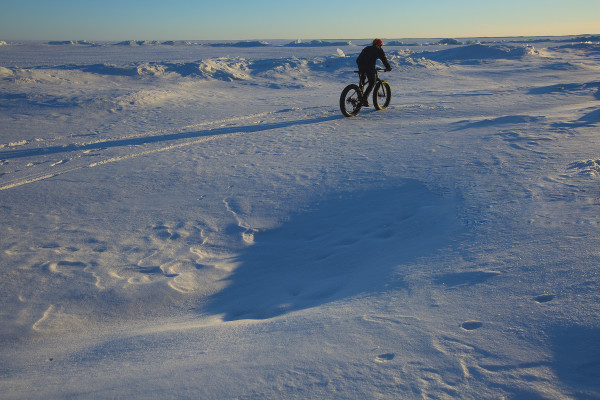
18 minutes away from my home trails of Cuyuna rests Lake Mille Lacs. It’s 20 miles long, and 26 miles wide. In the winter the lake provides a landscape that more resembles the North Pole than central Minnesota. For fat-bikes, an unmapped, untouched destination waiting to be discovered. Yet this month we’ll be crossing Mille Lacs on fat bikes. The Trek Farley 9.8 and Barbegazi tread are good allies to cover this land mass on frozen water.
Before we dive head first into this review, if you haven’t already, please read the summer review of the Trek Farley 9.8. For the purpose of time, this review will deal exclusively with the winter performance of the Farley 9.8 on snow.
Let’s not waste any time getting to the heart of the matter on this review. How did the Farley 9.8 perform on groomed single track, double track, and over the hills and through the frozen tundra woods?
27.5″ Wampa rims + Hodag tread on snow.
This was a complete surprise to me. I seriously enjoyed the 27.5″ experience on snow. Right away in our winter season we received an ideal amount of snow to mechanically groom our single track. Our single track is 20″ wide, if you tread outside of that sweet spot you’ll get into loose snow that can take you over the bars without notice.
Throughout my experience of riding on our single track the rolling momentum of the 27.5″ wheel set on snow was very good. The Wampa carbon wheel set continued it’s fast rolling attitude that I enjoyed in the summer. The ride experience was held back slightly by the lack of carving ability, but I’d squarely focus that symptom on the Hodag sidewall tire tread. If a Hodag 2.0 existed with a serious sidewall tread, I think we’d be off and running (and carving) on the winter groomed single track.
Snow climbing performance.
The good news for both the Hodag and Barbegazi tires is they both had zero problems in climbing any single track hills.
During the course of the past few months I also had an opportunity to ride the Farley 9.8 and the original Farley back to back on the same trail. This experience was essential to understand how far Trek has taken the new Farley 9.8 in terms of overall weight, responsiveness and climbing ability.
Upon saddling up the original Farley I was immediately aware of how heavy the rear end of that bike was in comparison to the Farley 9.8. I would equate the new 9.8 to what felt like a paperweight in comparison to the original Farley when climbing uphill. Keep in mind at the time (2013), the original Farley felt fast as could be! Kudos to Trek for that evolution. Having the ability to effortlessly climb hills was something I didn’t notice until I was on the original Farley. Sometimes you don’t know how good you have it, until it’s gone. This is a hallmark of what makes the 9.8 stand out.
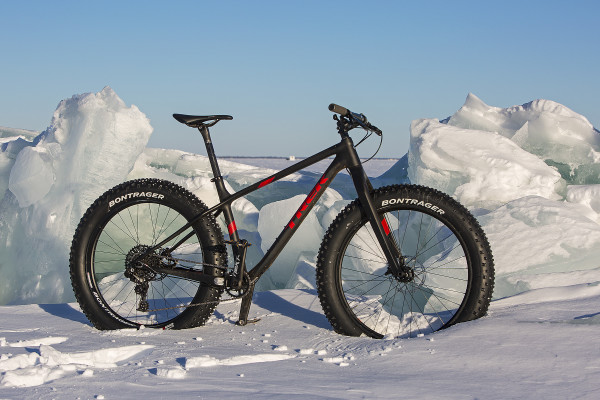
The Trek Farley 9.8 rests amid a Lake Mille Lacs ice pressure ridge on it’s north coast. In the background rests a well known Minnesota winter activity – fishing on ice in what we call a shack.
Enter the 26″ x 4.7″ Barbegazi.
After riding the 27.5″ Wampa wheel set for about a month I changed everything out. Out with the 27.5,” on with the 26.” Time to roll a serious fatty.
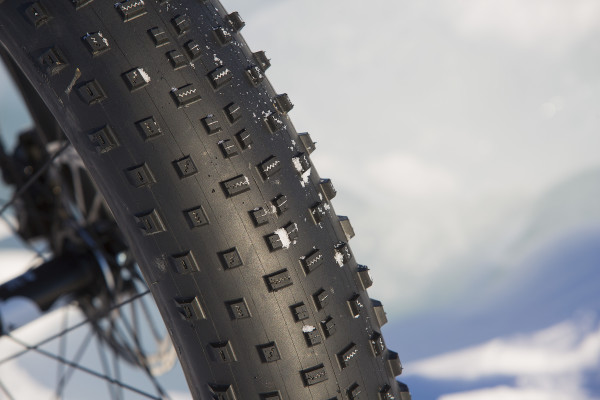
Barbegazi is a great snow tire tread for double track trails. Trails like we have in Cuyuna such as the Cuyuna Lakes State Paved Trail (10′ wide) or the Sagamore Unit (4′ wide). In Wisconsin, I’d highlight the Fat Bike Birkie trails where the Babegazi would gobble up and destroy other tires. When I pedaled Barbegazi on the double track trails I instantly shot forward in the pack. The reduced tread provided reduced rolling resistance which allowed me to gain speed on other cyclists who were slowed by the more aggressive tread pattern designed for groomed single track. Take special note on this depending on your preferred riding trails and conditions and upcoming race courses!
On the groomed single track it was noticeable that the Barbegazi had difficulty carving into the firm groomed snow on the fast, bermed-up corners. Cornering was doable, but not as intuitive as I have become to enjoy with other tire treads. Turning, rolling, and flowing was natural for the Farley and Barbegazi in the flow sections of the single track trails, but in comparison to the cornering performance of a 45NRTH Beist or Van Helga tire, Barbegazi finished in second place. Again though, take those same three tires out on the double track and you’d be pleased as punch to be riding the Barbegazi. So, focus on your trail riding preferences, and you’ll unlock the keys to Farley 9.8’s success.
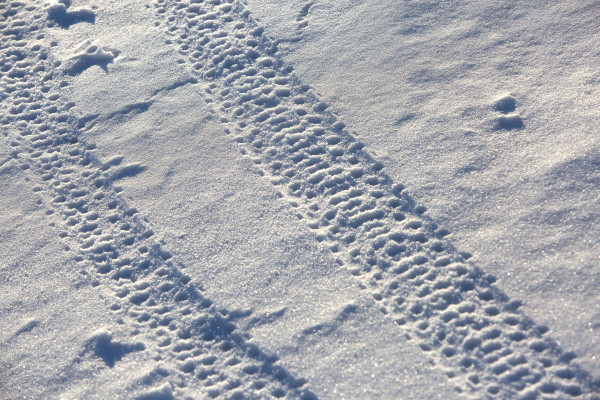
Here’s my thought. If I were to race/ride a fat-bike course that was mostly cross-country ski width trail, I’d mount the Barbegazi. The Farley 9.8 would roll as fast as the wind would blow and provide the necessary traction without adding any unnecessary rolling resistance. However, if racing a mostly single track race course, I’d proudly straddle the Farley 9.8 for it’s super fast climbing ability and rigid frame, and mount a 26″ x 4.7″ tire that provided a more aggressive sidewall tread. I believe the Farley 9.8 will reach it’s full potential when Bontrager releases the next tire that goes after an sidewall tread for ultimate single track carving.
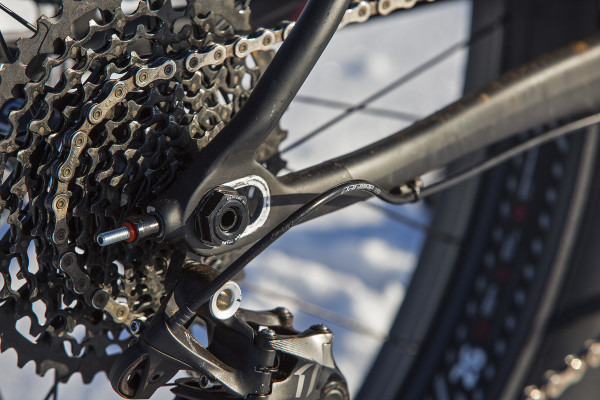
Farley’s stranglehold dropout again changed the “default setting” of the fat-bike world providing the ability to switch between wheel sets.
Getting ahold of the Stranglehold dropout.
When I wrote the review on the original Farley, Trek mentioned at that time they designed the original 3.8″ Farley to harness the width of the 3.8″ or 4.0″ fat-bike tire. At that time (2013) Trek’s position for this decision was made to increase speed, and to minimize rolling resistance on groomed fat bike trails.
And, with Farley 9.8 you still have that option of riding a 27.5″ x 3.8″ or 26″ x 4.7″ or 29″ x 3.” I’m personally hoping for an opportunity to ride 3.0″ (29″ or 27.5″) tires on groomed single track in the near future. Providing grooming techniques provide a solid/compact groomed base and the 3″ tire has a purpose-built snow tread, I think we’d be walking into a new generation of cycling that will gain traction fast.
Thanks to the Stranglehold we have one bike that could do all of the above. It’s still a year or two ahead of it’s time, but, what a deal to actually have the opportunity to try on this many wheel sizes for different riding experiences on one bike. (Providing you have the cash for 3 wheel sets) Also, as a passing note, I placed the rear axle in many different places within the dropout with both wheel sets to see if I noticed a difference in steering, cornering, rigidity. After many test rides I conclude that I could not tell a performance difference in position.
That’s okay, quite OK. The main point is you as the rider have the ability to have it your way when it comes to wheel size. If the trails are super hard-pack groomed with very little loose snow, throw on the 27.5″ and let ‘er rip. If you just received fresh snow and the trail crew groomed last night, install the 26″ wheel set and enjoy the additional float in the loose snow that otherwise might take your tire for a wild ride. If your trails allow 3″ on the groomed single track, and the trails are super hard, and super strong, guess what, let the 3″ tire rip! Plenty of different flavors to enjoy when rolling this fatty.
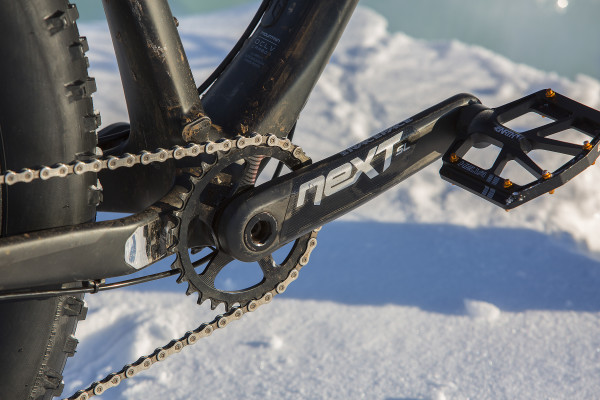
Always in season the RaceFace Next SL cranks. The only thing I’d change within this photo is swapping out the front chain ring for an elliptical Wolftooth Components chainring. The elliptical ring from my winter flat pedal riding experience provides a nice improvement on pedaling energy ROI.
In closing buying advice.
If you are looking for a lightweight, sharp-looking, well-equipped, easy to climb year-round fat-bike the 9.8 is a solid choice. I would suggest purchasing an additional 26″ tire set for groomed single track riding featuring an aggressive sidewall tread to increase the carvelicious factor. A summer consideration would be to install a suspension fork, the added weight wouldn’t be that great, but I think the ride quality would be amazing.
Future opportunities.
Here’s my personal wish list for the ’17 Farley:
• A 27.5″ x 4.0″ tire with aggressive sidewall tread for winter carving. I think there’s room to prove the 27.5″ rim is a groomed single track winter performer of choice, but a serious winter tire tread needs to come to the table first.
• An IsoSpeed decoupler to reduce the rigid in the rear
• Release the 9.9 with Di2 out of the box. Could be wonderful.
• Orange is a nice color.

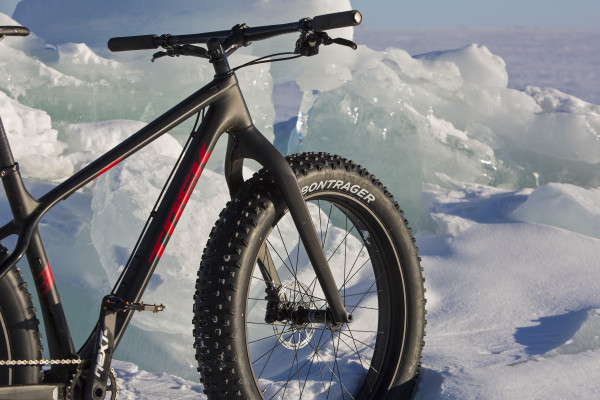
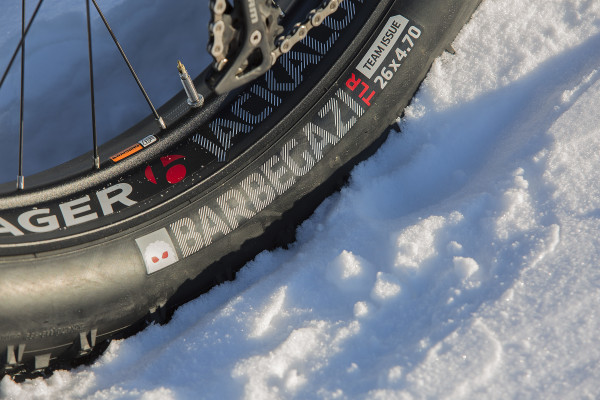
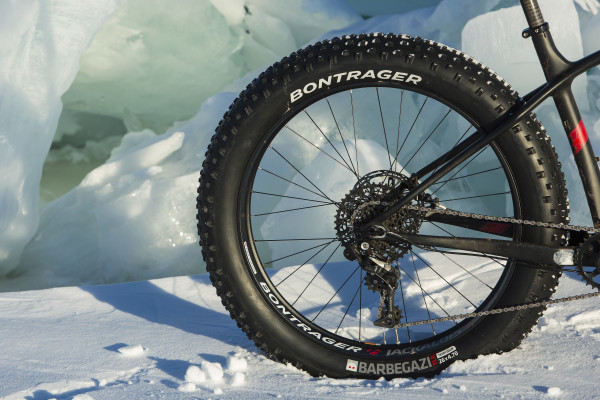
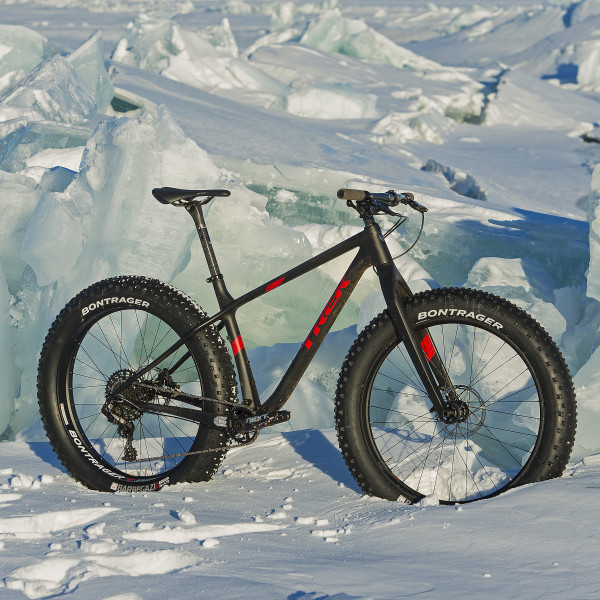
Great review Aaron! Bill Fleming is currently racing the 9.8 on the ITI trail all the way to Nome.
just wondering……………the 26 & 27.5 OD would probably be similar but a 29+ OD is significantly larger. How would this be compensated?
How about a review on the 27.5 x 4.5 Barbegazi or Gnarwhal on the 2017 Farley. Could it be the goldilocks?